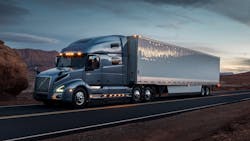Fleets are constantly looking for ways to reduce fuel consumption while also improving operational efficiency. The industry has responded to that demand by creating aerodynamic technologies and vehicle designs.
“The fuel consumption of a commercial vehicle can contribute to [the total cost of operations],” says Patrick Kealy, North American OE trailer business leader for Commercial Vehicle Control Systems (CVCS). “Aerodynamic products reduce air drag which can lower fuel consumption and CO2 emissions, so any improvements through reduction of aerodynamic drag is favorable to fleets and drivers.”
CVCS (formerly WABCO) is a division of ZF that specializes in vehicle technology manufacturing and brakes.
Though aerodynamic technologies offer fleets advantages, it should be noted this is not true on all trucks, says Dave Walters, manager of warranty and field service for Alcoa Wheel Products.
“If you’re a city truck or a regional truck, you really don't see the benefits of these [aerodynamic] devices,” Walters explains. “But if you're the over-the-road type of truck, there is definitely an advantage.”
Streamlining with aerodynamic products
When it comes to adding aerodynamic products to a vehicle, fleets have a variety of choices to mix and match to find what works best for them.
“A variety of areas on the tractor can be improved, including how the air hits the tractor, travels down the side of the tractor, and then transfers to the trailer,” says Allison Athey, product marketing manager for Volvo Trucks North America. “This translates on a Volvo tractor into bumpers with air deflectors underneath, chassis fairings with ground effects, cab side fairings with extenders, roof fairings with a trim tab, and the FlowBelow Tractor Aerokit.”
On other trucks, an aerodynamic set-up may look quite different. According to Walters, who acted as chairman for the Technology and Maintenance Council’s (TMC) Recommended Practice (RP) 261, Considerations for Aerodynamic Wheel Covers, he worked with many fleets on this committee, and they found skirting and wheel covers to be beneficial.
However, what works best for one fleet may not be best for another.
“As you start adding different components on, it’s not intuitive as to what will actually reduce drag,” says Doug Mason, global technical manager for Alcoa Wheel Products.
He uses the example of a fleet that adds a trailer skirt and sees 5 percent savings. The fleet then adds another component that should provide an additional 2 percent savings, but instead of seeing a total 7 percent in savings, they only realize 4 percent. The interaction between the two components did change the airflow, but because of the complexity of the truck and trailer designs themselves, the addition of the second aerodynamic device actually created more drag, Mason explains.
In the end, fleets looking to streamline their vehicles will need to go through some trial and error in order to find a good fit.
“The aerodynamics of trucks are just so complex, and the best data out there … belongs to the fleets,” says Mike Yagley, global program launch manager for Alcoa Wheel Products. “They know exactly what they get for the aerodynamics, when they add a hub cover … and they are going to know how that works with their boat tail, and they are going to know how that works at the fairing. And when they take [it] off, and they do all sorts of studies, they get all that data. They are really the experts.”
OEM vs. aftermarket aerodynamic products
OEM and aftermarket aerodynamic products each have their own benefits and drawbacks.
“The benefit of installing at the OEM assembly plant is that it is a more controlled environment with a process that helps to ensure proper installation for maximum efficiency,” CVCS’s Kealy says. “The ZF products are CARB and Smartway certified and not all competitive products are, including some sold through the aftermarket.”
Additionally, Volvo’s Athey points out, OEM products have been tested and verified by the OEMs for efficiency benefits and durability. Those products also have a factory warranty.
Sometimes though, it isn’t about whether the product is OEM or aftermarket.
“It’s how easily it is assembled onto the vehicle,” Alcoa’s Mason says. “Is that component going to be easy to maintain? If it is not, they are not going to order it from the OEM, and they are not going to buy it from the aftermarket. I don't know if there is really a question [of] either/or … it is the effectiveness.”
Installation and upkeep of aerodynamic devices
Proper installation and maintenance of aerodynamic devices are essential to achieving improved fuel efficiency.
Before installing any aerodynamic devices, fleets should be sure the device will give them the benefits desired, Kealy says. This means there should be documented and certified proof of fuel savings for that application. Next, fleets should follow the manufacturer’s installation guidelines, as designs can vary depending on trailer type and application.
Once the aerodynamic devices have been installed, upkeep is crucial.
“Don't ignore the aerodynamic devices during the scheduled periodic maintenance of the truck or trailer,” Kealy says. “Follow recommended service and inspection intervals. Perform visual inspection for any damage or signs of impact to the product, check bolt torques, and check the fit and clearance from the device to the truck or trailer. Check for cracks, dents, and deformations that would reduce overall air flow; the clearance and flow around the devices are what improves the aerodynamics and improves fuel economy.”
While using aerodynamic devices, fleets must also be aware that of the issues that come along with maintaining them. According to TMC’s RP 1110 – Inspection and Maintenance Recommendations for Aerodynamic Devices – there are three reasons aerodynamic devices can increase maintenance requirements.
- Some aerodynamic devices themselves are easily damaged and require replacement.
- The devices can damage parts of the vehicle to which they are mounted, such as the cab roof or the back of the cab.
- Devices may obstruct access to items on the vehicle requiring maintenance, increasing time required to perform maintenance.
TMC also notes that ground clearance is becoming an issue, as some aerodynamic devices are causing tractors decreased maneuverability into locations that were accessible before the devices were added.
With this information in mind, fleets must do their research prior to adding aerodynamic devices to their vehicles. If a fleet does decide to add them, proper installation and maintenance are key.
Counteracting unintended consequences of aerodynamic devices
Though aerodynamic devices can be beneficial to increase a fleet’s fuel efficiency, they also have the potential to cause problems.
Aerodynamic devices are tools fleets can use to reduce drag on their vehicles and increase fuel efficiency. But before fleets decide to add these devices, it is important they know some of the unintended additional maintenance that can be caused by aerodynamic devices. The Technology & Maintenance Council’s (TMC) Recommended Practice (RP) 1110 – Inspection and Maintenance Recommendations for Aerodynamic Devices – covers four areas on a truck that could be impacted by the addition of an aerodynamic device.
Drivetrains
The problem
Vehicles using aerodynamic products that obstruct air flow underneath the vehicle could direct air away from certain components that rely on it for cooling. This could increase the temperature of components such as the transmission, for example, reducing the lifespan of the gear, synchronizer, bearing, and seal.
TMC’s Recommendation
Many transmission suppliers recommend gear oils not be used in transmissions, so fleets should try using SAE 50 weight engine oils in the transmission instead – nothing more viscous. Additionally, fleets should consider spec’ing oil coolers on tractors equipped with engines over 350 horsepower, as well as make sure the coolers are installed where they can work properly. Lastly, choose the appropriate viscosity grade gear oil or synthetic lube oil in drive axles.
Brakes
The problem
With less wind resistance helping to slow it down, the brakes on a vehicle with aerodynamic devices absorb more energy, meaning there are more brake applications for the same amount of retardation and a higher brake operating temperature. Additionally, if the aerodynamic device reduces air flow over the brakes, this can shorten the life of brake components.
TMC’s Recommendation
Increased inspection of the brakes, as well as the potential adoption of retarders on very “aerodynamically clean” tractors.
Cab structure
The problem
When installing aerodynamic devices, any places where the attachment hardware goes through the cab skin are potential areas for corrosion development. In time, these areas could also present fatigue cracks.
TMC’s Recommendation
Frequent visual inspections will help prevent major repair work from being required. Look for hairline cracks and corrosion at mounting bolt locations and repair any that are found according to the manufacturer’s instructions for that cab material.
Refrigeration units
The problem
Certain aerodynamic devices – full cab, roof-mounted air fairings and cab extenders particularly – can cause loss of refrigeration unit cooling because of heat drawn from the tractor. Occasionally, this will lead to a total unit shutdown.
TMC’s Recommendation
Managing the airflow in and around the refrigeration unit can improve its efficiency. For fleets in hot or humid areas, drivers should pay close attention to the vehicle’s temperature. Additionally, fleets may need to install thermometers outside the trailer so they can be read during walk-around inspections or deliveries. TMC also recommends simple recording thermometers be installed on the front face of the trailer to track the temperature between the tractor and trailer. It should be noted that if that temperature reaches 100 degrees F, reduced cooling efficiency will result.
About the Author
Emily Markham
Assistant Editor | Vehicle Repair Group
Emily Markham is an assistant editor for the Vehicle Repair Group.
With an education based in writing and editing, Markham uses her knowledge to assist with the creation of content for Endeavor Business Media Vehicle Repair Group’s publications—Fleet Maintenance, Professional Tool & Equipment News (PTEN), and Professional Distributor—as well as their website, VehicleServicePros.com.

